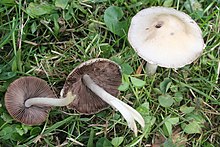| Candolleomyces candolleanus | |
|---|---|

| |
| Scientific classification | |
| Domain: | Eukaryota |
| Kingdom: | Fungi |
| Division: | Basidiomycota |
| Class: | Agaricomycetes |
| Order: | Agaricales |
| Family: | Psathyrellaceae |
| Genus: | Candolleomyces |
| Species: | C. candolleanus
|
| Binomial name | |
| Candolleomyces candolleanus (Fr.) D. Wächt. & A. Melzer (2020)
| |
| Synonyms[1] | |
| |
Candolleomyces candolleanus (formerly known as Psathyrella candolleana) is mushroom in the family Psathyrellaceae. It is commonly found growing in small groups around stumps and tree roots on lawns and pastures[2] in Europe and North America. In 2014, it was reported from Iraq.[3] The coloring varies between white and golden brown. The cap is tan when young,[2] growing to 2–8 cm (1–3 in) in diameter,[4] initially conical, later becoming rounded and finally with upturned margins in maturity. The cap margin is irregular and radially asymmetrical—a defining characteristic of this species. It can retain veil fragments on the edge and center.[2] The white stalk[2] is 4–10 cm (1.5–4 in) tall and 3–7 mm wide.[4] The spore print is purple-brown, while spores are smooth and elliptical, measuring 6.5–8 by 4–5 µm.[5] The specific epithet candolleanus honors Swiss botanist Augustin Pyramus de Candolle.[6]
While it is edible and may have a good flavor, it is not recommended due to its thin flesh, alleged poor culinary value and consistency, as well as difficulty in identification.[2][7][8]
One similar species is Psathyrella gracilis.[4] Some species may have darker caps when young, drying to match that of P. candolleana.[2]
See also[edit]
References[edit]
- ^ "Candolleomyces candolleanus (Fr.) D. Wächt. & A. Melzer 2020". MycoBank. International Mycological Association. Retrieved 2022-07-05.
- ^ a b c d e f Trudell, Steve; Ammirati, Joe (2009). Mushrooms of the Pacific Northwest. Timber Press Field Guides. Portland, OR: Timber Press. p. 202. ISBN 978-0-88192-935-5.
- ^ Al-Habib MN, Holliday JC, Tura D (2014). "The pale brittle stem mushroom, Psathyrella candolleana (higher Basidiomycetes): An indigenous medicinal mushroom new to Iraq". International Journal of Medicinal Mushrooms. 16 (6): 617–22. doi:10.1615/intjmedmushrooms.v16.i6.110. PMID 25404226.
- ^ a b c Davis, R. Michael; Sommer, Robert; Menge, John A. (2012). Field Guide to Mushrooms of Western North America. Berkeley: University of California Press. pp. 233–234. ISBN 978-0-520-95360-4. OCLC 797915861.
- ^ Huffman DM, Tiffany LH, Knaphaus G, Healy RA (2008). Mushrooms and Other Fungi of the Midcontinental United States. University of Iowa Press. p. 65. ISBN 978-1-58729-725-0.
- ^ Evenson VS. (1997). Mushrooms of Colorado and the Southern Rocky Mountains. Big Earth Publishing. p. 136. ISBN 978-1-56579-192-3.
- ^ Jones, Julie. "Psathyrella candolleana". Burke Herbarium Image Collection. Retrieved 2022-08-01.
- ^ Miller Jr., Orson K.; Miller, Hope H. (2006). North American Mushrooms: A Field Guide to Edible and Inedible Fungi. Guilford, CN: FalconGuide. p. 238. ISBN 978-0-7627-3109-1.
External links[edit]
| Candolleomyces candolleanus | |
|---|---|
| Gills on hymenium | |
| Cap is conical or convex | |
| Hymenium is adnate or seceding | |
| Stipe is bare or has a ring | |
| Spore print is purple-brown | |
| Ecology is saprotrophic | |
| Edibility is edible but not recommended | |
![]() Media related to Candolleomyces candolleanus at Wikimedia Commons
Media related to Candolleomyces candolleanus at Wikimedia Commons